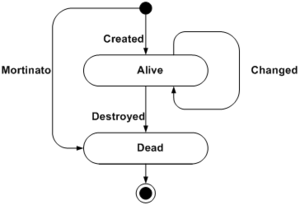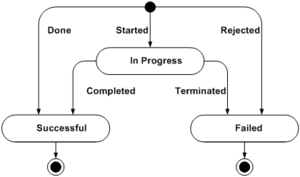Contents
Transaction Monitoring States
This section presents models (including substates and transitions) of the states related to transaction monitoring: the Object, Abstract Transaction, IS Link Creation Feature, Call Operation Feature, and Resource Feature states.
Object State
Transitions
- created—For an object that has just been created; the first transition for every object (from initial to alive).
- changed—An object's attributes have been changed (from alive to alive).
- destroyed—An object has just been destroyed; the last transition for every object (from alive to dead).
- mortinato—An object has been created and destroyed at one time; the last transition for every object (from initial to dead).
Appearance
The Object component is present with every object instance, from the initial to the final transition. All attributes of an object component are present with every object instance at all times.
If the object instance has exactly one transition, for instance, iscc.transaction.rejected or iscc.transaction.done, the object component of such an object instance has one transition as well. In this case the transition is object.mortinato.
If the object instance has two transitions, for instance, iscc.transaction.started and iscc.transaction.completed, the object component of the object instance has two transitions: object.created and then object.destroyed.
If the object instance has more then two transitions, the object component of this object instance is present for every notification event. The first notification event has a transition of object.created.
The last notification event has a transition object.destroyed. Notification events that occur between those two have a transition of object.changed.
Abstract Transaction State
SubStates
- in-progress—The transaction instance is in progress.
- successful—The transaction instance has successfully completed.
- failed—The transaction instance has abnormally terminated.
Transitions
- started—Transaction instance has started (from initial to in-progress).
- completed—Transaction instance has completed successfully (from in-progress to successful).
- terminated—Transaction instance has completed abnormally (from in-progress to failed).
- done—Transaction instance has started and has completed successfully at the same time (from initial to successful). This transition might be considered as two consecutive transitions—started and completed—occurring without an intermediate delay. Such a transition might happen when the initial conditions for this transaction instance are met (all the required resources are available), and the transaction can be completed at this same time.
- rejected—Transaction has started and has completed abnormally at the same time (from initial to failed). You could consider this transition as two consecutive transitions—started and terminated—occurring without an intermediate delay. Such a transition might happen when the initial conditions for this transaction are not met (a required resource is permanently unavailable), or the transaction can never succeed.
Appearance
The Abstract Transaction component is present with every object instance, from the initial to the final transition. All attributes of an abstract transaction component are present with every object instance and at all times.
IS Link Creation Feature State
SubStates
- in-progress—IS Link creation is in progress.
- successful—IS Link creation has successfully completed.
- failed—IS Link creation has terminated abnormally.
Transitions
- started—IS Link creation has started (from initial to in-progress).
- completed—IS Link creation has completed successfully (from in-progress to successful).
- terminated—IS Link creation has completed abnormally (from in-progress to failed).
- done—IS Link creation has started and has completed successfully at the same time (from initial to successful). This transition might be considered as two consecutive transitions—started and completed—occurring without an intermediate delay.
- rejected—IS Link creation has started and has completed abnormally at the same time (from initial to failed). You could consider this transition as two consecutive transitions—started and terminated—occurring without an intermediate delay.
Appearance
The IS Link Creation feature component works asynchronously with respect to the Call Operation and Resource features. The IS Link Creation feature component starts when all checks for transaction validity have successfully passed. It ends when the transaction instance ends. Attributes of this component are present with the transaction instance from the time the IS Link Creation feature component starts and till it ends.
Call Operation Feature State
SubStates
- in-progress—Call operation is in progress.
- successful—Call operation has successfully completed.
- failed—Call operation has abnormally terminated.
Transitions
- started—Call operation has started (from initial to in-progress).
- completed—Call operation has successfully completed (from in-progress to successful).
- terminated—Call operation has completed abnormally (from in-progress to failed).
- done—Call operation has started and completed at the same time (from initial to successful). This transition might be considered as two consecutive transitions—started and completed—occurring without an intermediate delay.
- rejected—Call operation has started and has completed abnormally at the same time (from initial to failed). You could consider this transition as two consecutive transitions—started and terminated—occurring without an intermediate delay.
Appearance
The Call Operation feature component works asynchronously with respect to the IS Link Creation and Resource features. The Call Operation feature component starts when ISCC starts performing a given call operation to fulfill a multi-site operation. Usually, it represents a request/response message pair. The Call Operation feature component ends when the transaction instance ends. (The attribute iscc.call-operation.call-id is present when a call related to the call operation is known.)
Resource Feature State
SubStates
- exclusive—The resource has been acquired in exclusive mode.
- shared—The resource has been released, and might be acquired by another transaction.
- pending—A resource is temporarily unavailable.
- unavailable—A resource is permanently unavailable.
Transitions
- acquired—The resource has been acquired exclusively (from initial to exclusive).
- released—The resource has been released (from exclusive to shared).
- postponed—The resource is temporarily unavailable; the transaction has been postponed (from initial to pending).
- resumed—The resource is available; the transaction has resumed (from pending to exclusive).
- rejected—A resource is unavailable permanently from the outset; the transaction has been rejected (from initial to unavailable).
- terminated—A resource became unavailable permanently; the transaction has been terminated (from pending to unavailable).
Appearance
The Resource feature component works asynchronously with respect to the IS Link Creation and Call Operation features. The Resource feature component starts when ISCC tries for first time to acquire a resource required for the multi-site operation. The Resource feature component ends when the transaction instance ends. The attribute iscc.resource.name is present from the time when ISCC successfully acquires the corresponding resource.





